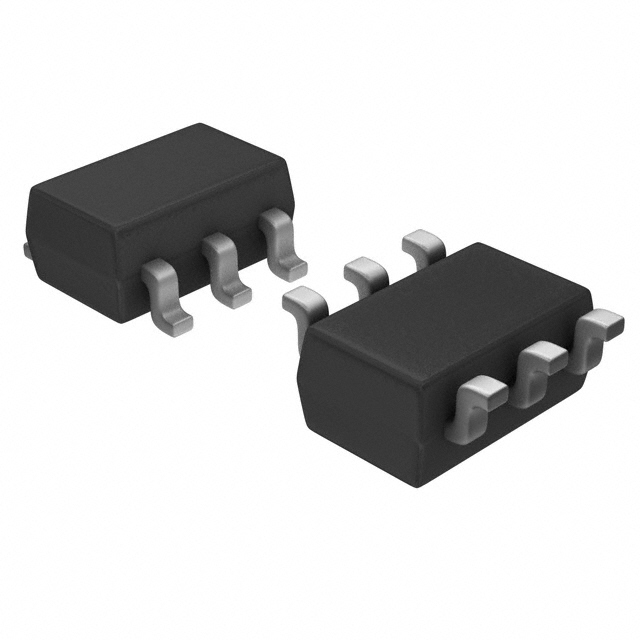Consulte las especificaciones para obtener detalles del producto.

ADS1100A5IDBVR
Product Overview
Category
The ADS1100A5IDBVR belongs to the category of analog-to-digital converters (ADCs).
Use
It is primarily used for converting analog signals into digital data.
Characteristics
- Low power consumption
- High resolution
- Small package size
- Wide operating voltage range
Package
The ADS1100A5IDBVR comes in a small SOT-23 package.
Essence
The essence of the ADS1100A5IDBVR lies in its ability to accurately convert analog signals into digital form, making it suitable for various applications.
Packaging/Quantity
This product is typically packaged in reels and is available in quantities of 3000 units per reel.
Specifications
- Resolution: 16 bits
- Input Voltage Range: ±2.048V
- Operating Temperature Range: -40°C to +125°C
- Supply Voltage: 2.7V to 5.5V
- Conversion Rate: Up to 128 samples per second
Detailed Pin Configuration
The ADS1100A5IDBVR has the following pin configuration:
- VDD: Power supply input
- GND: Ground reference
- AIN0: Analog input channel 0
- AIN1: Analog input channel 1
- SDA: Serial data output
- SCL: Serial clock input
Functional Features
- High-resolution conversion
- Low power consumption
- I2C interface for easy integration
- Programmable gain amplifier
- Internal voltage reference
Advantages and Disadvantages
Advantages
- High accuracy and resolution
- Low power consumption
- Small package size
- Wide operating voltage range
Disadvantages
- Limited number of analog input channels
- Relatively low conversion rate compared to some other ADCs
Working Principles
The ADS1100A5IDBVR utilizes a successive approximation register (SAR) architecture to convert analog signals into digital data. It employs an internal voltage reference and a programmable gain amplifier to achieve high accuracy and resolution.
Detailed Application Field Plans
The ADS1100A5IDBVR finds applications in various fields, including:
- Industrial automation: for monitoring and control systems
- Medical devices: for precise measurement of physiological signals
- Energy management: for power monitoring and energy metering
- Sensor interfaces: for converting sensor outputs into digital form
- Data acquisition systems: for capturing analog signals in digital format
Detailed and Complete Alternative Models
- ADS1115: 16-bit ADC with four input channels and higher conversion rate
- ADS1015: 12-bit ADC with four input channels and lower power consumption
- MCP3421: 18-bit ADC with I2C interface and programmable gain amplifier
These alternative models offer different features and specifications, providing options based on specific application requirements.
Word count: 345 words
Enumere 10 preguntas y respuestas comunes relacionadas con la aplicación de ADS1100A5IDBVR en soluciones técnicas
Sure! Here are 10 common questions and answers related to the application of ADS1100A5IDBVR in technical solutions:
1. What is the ADS1100A5IDBVR? - The ADS1100A5IDBVR is a precision analog-to-digital converter (ADC) with a 16-bit resolution.
2. What is the operating voltage range of the ADS1100A5IDBVR? - The ADS1100A5IDBVR operates from a single power supply voltage ranging from 2.7V to 5.5V.
3. What is the typical conversion rate of the ADS1100A5IDBVR? - The ADS1100A5IDBVR has a typical conversion rate of 8 samples per second (SPS).
4. Can the ADS1100A5IDBVR be used for temperature sensing applications? - Yes, the ADS1100A5IDBVR can be used for temperature sensing applications as it has an integrated temperature sensor.
5. What is the input voltage range of the ADS1100A5IDBVR? - The ADS1100A5IDBVR has an input voltage range of -0.3V to VDD + 0.3V.
6. Does the ADS1100A5IDBVR have built-in programmable gain amplification? - No, the ADS1100A5IDBVR does not have built-in programmable gain amplification.
7. What is the interface used to communicate with the ADS1100A5IDBVR? - The ADS1100A5IDBVR uses an I2C interface for communication with the microcontroller or host device.
8. Can the ADS1100A5IDBVR operate in a low-power mode? - Yes, the ADS1100A5IDBVR has a low-power mode that can be enabled to reduce power consumption.
9. What is the resolution of the ADS1100A5IDBVR? - The ADS1100A5IDBVR has a 16-bit resolution, which allows for high-precision measurements.
10. Is the ADS1100A5IDBVR suitable for battery-powered applications? - Yes, the ADS1100A5IDBVR operates at low power and can be used in battery-powered applications where power efficiency is important.
Please note that these answers are general and may vary depending on the specific application and requirements.

